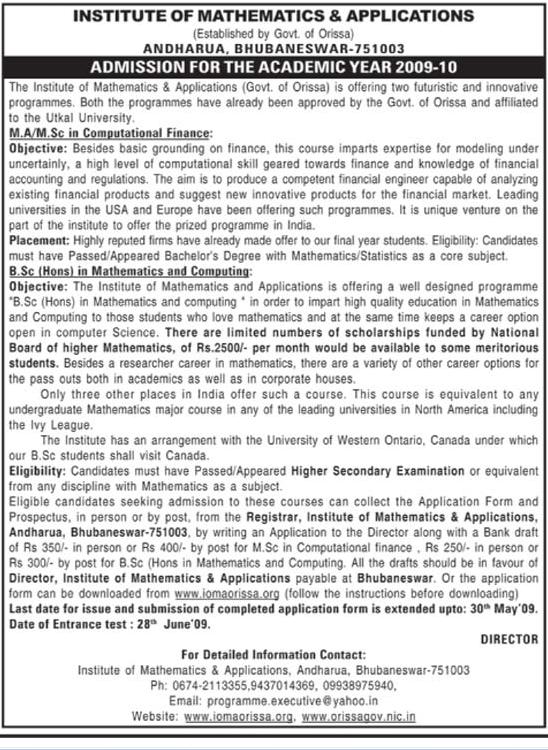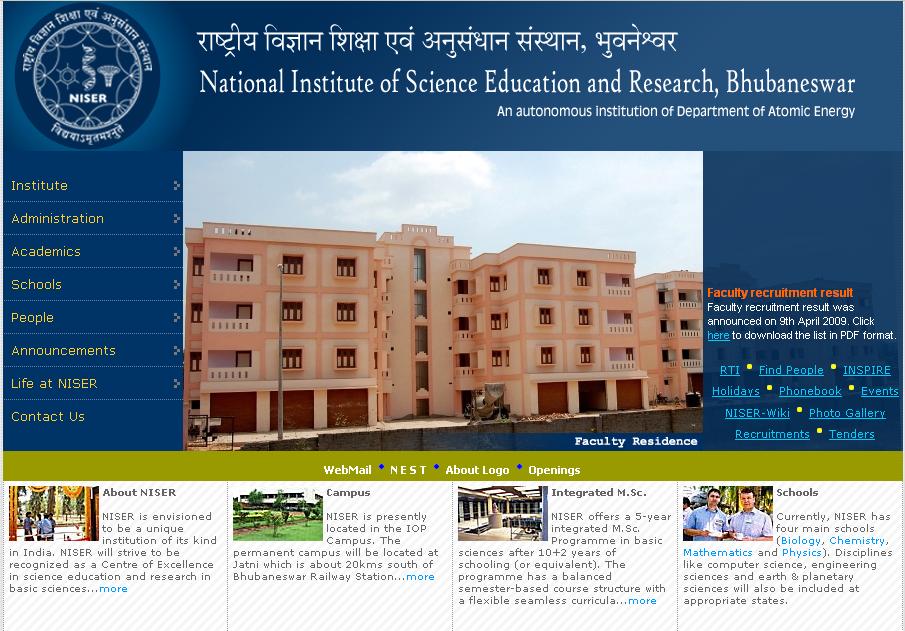Following are some excerpts from the news report in expressbuzz.com.
- The National Institute of Science Education and Research (NISER), Bhubaneswar, is set to start PhD programmes from December this year.
- … It would be followed by an integrated PhD programme that would commence from August next year.
- … it plans to introduce new streams like Earth and Planetary Sciences, Environment Science and Computer Science by 2013.
- … the institution would move to its own campus at Jatni by 2013
- …. With the campus complete, the NISER would have about 1,000 UG and 700 PhD students along with 250 faculty members and 500 staff.
- … In the next two years, the intake would be 80 which would further go up to 200 in each wing by 2013.
- … Plans are also afoot to introduce a national combined entrance examination for NISER along with IISERs at Trivandrum, Bhopal, Mohali, Kolkata and Pune on the lines of IIT. At present, the IISERs are taking students from the extended merit list of IIT entrance examinations.
- NISER would also, from the next year, adopt one CBSE pattern school in the State to train its students to be absorbed in it for higher studies
Following is an excerpt from a report in Orissadiary.
- Prime Minister Manmohan Singh is expected to lay the foundation stone for the new campus of the prestigious National Institute for Science Education and Research (NISER) near here next month. Though the exact date is yet to be finalised, the foundation stone for our own campus is likely to be laid by the Prime Minister by the second week of July, NISER director Prof T K Chandrasekhar told the media persons.
Following are excerpts from a report in Business Standard.
- The total cost of setting up the new campus is Rs 770 crore. Construction work on the new campus is expected to commence by February 2010.
- In the beginning NISER would be affiliated to Homi Bhabha National Institute, a deemed university within the Department of Atomic Energy, for the award of degrees. At a later stage it will seek UGC approval to get the status of a deemed university for awarding degrees on its own.
June 12th, 2009
The ad is at http://niser.ac.in/notices/2009/new-faculty.php. Following are some excerpts. It has the updated salary numbers. The IISER ads as of now – Trivendrum, Bhopal, Mohali, Pune, Kolkata – seem to have the old salary numbers.
National Institute of Science Education and Research
Institute of Physics Campus, Bhubaneswar
web : http://niser.ac.in
Faculty Positions at NISER
Invitation to be part of a new initiative in science education
The National Institute of Science Education and Research (NISER) has been setup at Bhubaneswar by the Department of Atomic Energy of the Government of India to be a unique institution of its kind pursuing undergraduate and post-graduate education in science combined with frontline research. The Government of India has made a very generous financial outlay to NISER for the purpose of setting up state-of-the-art research facilities in all branches of basic science and to promote interdisciplinary areas of research.
NISER is being setup in a sprawling 300 acre campus about 3 km from Khurda Road Railway Station on the outskirts of Bhubaneswar overlooking Barunei Hills. It will be a fully residential campus with modern living amenities including children’s school and health centre.
…
NISER invites applications in the disciplines of Biology, Chemistry, Mathematics and Physics from extremely motivated Indian scientists with a high-profile research agenda and a flair for teaching (especially at the undergraduate level) for the following faculty positions bearing scale of pay given against each:
| Assistant Professor |
15,600 – 39,100 |
| Reader (F) |
37,400 – Rs 67,000 |
ASST. PROFESSOR : Pay Band Rs 15,600 – 39,100 + Grade Pay 7,600
Basic pay on initial appointment will be Rs 29,920 + 22% D.A at current rates + 20% HRA on basic pay. Total emoluments will be approximately Rs 44,438/- per month.
Minimum Qualification
A Ph.D degree in the relevant discipline from a reputed university or institute. Two years of postdoctoral experience preferably abroad with high quality publication in high impact journals.
Age – Preferably 30-37 years
READER (F) – Pay Band Rs 37,400 – 67,000 + Grade Pay 8,700
Basic pay on initial appointment will be Rs 46,100 + 22% DA at current rates + 20% HRA on basic pay. Total emoluments will be approximately Rs 67,414/- per month.
Minimum Qualification
A Ph.D degree in the relevant discipline from a reputed University or Institute. At least 4-5 years of postdoctoral experience preferably abroad with high quality publication in high impact journals.
Age Limit – Between 37-42 years
The age of superannuation is 65 years. In addition to the basic salary, NISER faculty is entitled to allowances as admissible to Central Government Employees stationed at Bhubaneswar and to the DAE’s update allowance, which is currently Rs. 10,000 to Rs. 30,000 per year depending on the scale of pay. They will also receive other fringe benefits (like Relocation Grant, Reimbursement of telephone charges, financial support to attend national/international Conferences/Seminars/Workshops, etc.) which will be comparable to the best in the country.
NISER has sufficient funds to provide seed money to the new faculty to start their research programme. In addition the Department of Atomic Energy provides generous grants from its Prospective Research Fund to bright young scientists.
Interested candidates may apply enclosing:
- Curriculum Vitae
- List of Publications (with reprints of important papers as pdf files)
- Names and addresses (with e-mail and fax number) of at least three referees
- A statement of purpose and research programme
The qualification and experience prescribed are the minimum and mere possession of the same does not entitle a candidate to be considered for any position. However, the experience criteria may be relaxed for exceptionally meritorious candidates.
Applications should be sent by e-mail to careers [at] niser [dot] ac [dot] in marking "Faculty in (branch)" in the subject field (branch being one of the disciplines mentioned above). This is an open advertisement and there is no time limit for sending the application, but the applications received will be taken up for consideration at regular intervals. Candidates are advised to request the Referees to send their letters of recommendations (preferably signed versions as pdf file) directly to NISER at the above e-mail address. Those having regular job in any organization should also send a "No Objection Certificate" from the current employer in electronic form.
All correspondence should be addressed to the above e-mail address only (or any other e-mail address that is notified on the NISER website in future). No postal correspondence is required at any stage. Enquiry regarding the outcome of the application is generally discouraged.
-Director
June 6th, 2009
Update: Dharitri reports that so far 18 faculty have been hired.
Following is an excerpt from a report in Times of India.
"Last year, we admitted 120 students to three streams: civil, mechanical and electrical (40 students each). The number would the same this year," IIT-Bhubaneswar registrar B K Ray told TOI. According to him, 240 students (of both batches) would be taught at IIT-Kharagpur Extension Centre building here. "Three laboratories are being set up. Everything should be ready in time," Ray said.
"Since no hostel is available now, we have taken 50 new apartments on rent at SBI Colony in the Jharpada area for students’ accommodation. A private party would do the catering job, while for transportation of students from the apartments to classrooms the distance is seven km we will hire three-four buses," the registrar said.
Around 935 acre has already been earmarked at Kansapada in Jatni, about 30 km from here, for construction of a permanent campus of IIT-Bhubaneswar.
"It will take at least three years to build the new campus. We aim to start classes on the permanent campus in 2011," Ray said….
IIT officials said they have got approval to open courses in different subjects, but as of now they want to concentrate on civil, mechanical and electrical streams to ensure no dilution of quality took place.
"There is no need to rush. We have started recruiting teachers. Apart from IIT-Kharagpur teachers, some retired IIT and Institute of Physics and National Institute of Science, Education and Research (NISER) teachers will join us," Ray added.
May 30th, 2009
Following is an excerpt from a report in thaiindian.com.
Azad said the ministry would also try to speed up the setting up of six institutes on the lines of the All India Institute of Medical Sciences (AIIMS). The government had announced the plan in 2003, but it was given a final go ahead in 2005.
Under the scheme, such institutes would be set up in Patna, Bhopal, Bhubaneswar, Jodhpur, Raipur and Rishikesh. Azad also said the ministry would upgrade 13 other medical institutes in the country.
He said after the six AIIMS like institutes come up, the government plans to start two more such institutes and also upgrade six medical institutes.
May 29th, 2009
Following is an excerpt from a report in expressbuzz.com.
A preliminary estimate puts the number of successful candidates from the State at about 200 – including those who secured All India Ranks (AIR) and those who figured in the extended merit list announced on Monday.
While 150 students are believed to have cleared the test from Bhubaneswar alone, 11 students of Jawahar Navodaya Vidyalaya, Mundali, in Cuttack notched up good ranks.
Initial reports said approximately 10 students from Berhampur and another 20 from Rourkela made it to the extended merit list.
This IIT success rate is probably the best ever in the State with one student, …
JNV, Mundali, where about 39 students were given special coaching for IIT, saw its student Abhisek Rai getting AIR 1,948 (placed 258th in OBC category list).
Another student, Pratapbandhu Solanki, has secured 12th rank in Scheduled Tribe (ST) category, whereas Sourav Ginnore got 232nd rank in Scheduled Caste category.
Similarly, Ravindra Chourase (324), Saroj Nayak (437), Ranu Choudhury (543), Rakesh Malick (692), Soumya Ranjan Sahoo (731), Nitesh Patra (831) and Kamlesh Ahirwar (953) are among the successful candidates in the SC list, school principal S B Rao said.
The private IIT tutorial institutions were ecstatic about the results. Akash Institute claimed at least 91 of its students cleared the all-India entrance.
Director A B Singh said 24 of its students were on the merit list, while the rest were on extended list.
Similarly, Vidwan claimed 56 students followed by Naidu with 11 and Kalinga Bharati with about 20 students.
… From Kharagpur zone, of 52,176 students, only 928 students qualified. The result percentage in Kharagpur zone is below 2 per cent.
May 26th, 2009
Update: IIT Bhubaneswar web page now lists Prof. Madhusudan Chakroborty as the director.
Following is an excerpt from a report in the Times of India.
Functioning under temporary arrangement for over a year, the newly-created six IITs have now got their regular directors.
Prof U B Desai, Prof M K Surappa, Prof Sudhir Kumar Jain, Prof Prem Kumar Kalra, Prof Madhusudan Chakroborty and Prof Anil Bhowmick will head the IITs at Hyderabad, Ropar, Gandhinagar, Rajasthan, Bhubaneswar and Patna respectively.
"The Union Cabinet has given its go ahead for the appointment of the directors who were selected by the search committee. We have issued appointment letters to the new directors last week," a senior HRD ministry official said.
May 26th, 2009
Orissatv.com reports in http://orissatv.com/NewsDetail.asp?newsId=NS3601 that 300 Orissa students cracked the IIT entrance. If that means they qualify for the IIT then it is a great improvement over previous years. If the 300 includes the exttended merit list then one needs the data regarding how many are in the EML and how many qualified for the IITs. If even half of the 300 qualified for IIT then also it is an improvement over the previous years. The article goes on to say:
The state students performed well only after the establishment of an IIT in Bhubaneswar recently.
However, Orissa is still far behind other states. For example, 2000+ qualified from Andhra Pradesh. Comparable to Orissa is Gujarat from where 167 qualified to the IITs and 175 are in the extended merit list.
Update: Dharitri says 700 qualified from Orissa.
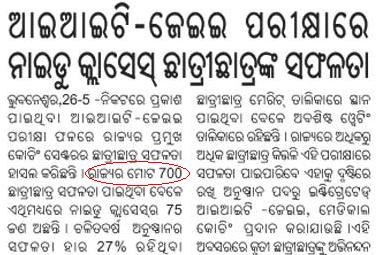
May 26th, 2009
Following is from http://niser.ac.in/notices/2009/benefits4NISER.php.
M.Sc. graduates of NISER who are interested to join BARC, will be given exemption from writing the Training School examination and will be directly eligible for interview.
Furthermore, NISER students interested in pursuing Ph.D. programme can be considered for K.S. Krishnan fellowship directly in any DAE institution.
May 21st, 2009
Update: The comment below is correct. They have had the Ph.D program since January 2009. Perhaps the MHRD found out about it recently and put out a PIB release and as a result various news items came about.
Following is from http://www.dnaindia.com/report.asp?newsid=1255708.
The newly-created Indian Institute of Technology, Hyderabad, will offer Masters and PhD programme from the coming session.
It will offer Masters of Technology (M Tech) Degree in five subjects — Chemical Engineering, Computer Science and Engineering, Electrical Engineering and Mechanical Engineering, the HRD Ministry said in a statement today.
Similarly, students can pursue PhD in nine subjects. These are Chemical Engineering, Chemistry, Civil Engineering, Computer Science and Engineering, Electrical Engineering, Humanities and Social Sciences, Materials Science and Engineering, Mathematics, Mechanical Engineering and Physics.
Meritorious candidates can avail scholarships. The institute will entertain only on-line applications. The last date for applying for the courses is May 20.
I have not heard about similar offering of post-graduate courses in the other new IITs.
May 13th, 2009
After the problems with wrong evaluations with respect to IIT JEE question papers, NEST, the entrance examination for NISER and UM-DAE, plans to take a cautious approach. Following is from NISER-NEST 2009 web page:
NEST question papers and correct answers to the questions of NEST examination conducted on May 10 2009 will be available HERE on May 12 at 4 pm is available HERE Since May 12, 4:00 pm.
Candidates or any other persons may send their comments to feedback [at] niser.ac.in
Comments received till May 20 will be put before the NEST Examination Committee. These comments will be reviewed by the committee and the final correct answers will be announced.
The decision of the Paper Setter’s Committee regarding the correct answers will be final.
This show of humility by the NEST question setters is refreshing.
May 12th, 2009
Following are from postings in the NISER orkut community about the NEST exam in the previous two years.
The pattern of NEST is somewhat as follows : The paper consists of 5 parts –
1. General, 2. Physics, 3. Chemistry , 4. Biology, 5. Mathematics
The General section is mandatory for all. Amongst the other 4, you are supposed to attend ANY 3. All sections carry equal weightage. Regarding the query about scientists and contributions, such kind of questions needn’t be expected in the NEST exam. It basically checks your analytical skill, reasoning and application of concepts. Hence, direct formulae, simple numericals etc. are less probable in NEST.
There will be questions with only one correct answer as well as more than one right alternative. As with the case of SPECIAL textbooks for NEST, your thorough knowledge of basic concepts will be your best guide in the exam, as it evaluates your ability to reason properly, apply your knowledge and arrive at the answer.
!sh@n
abt question types ,
hi ,
The previous year’s paper are not released in public domain yet . however i can assure u it is not like any engineering or medical competitive exam papers. The questions require more analysis and are more thought-provoking. n about books , i think ncert books plus some books with sound theoretical concept would help .
!sh@n
>>henry
analytical questions like, u might be given some graphs or a trend of any sort n u l need to answer based on wht u deduce frm it ( eg bacterial population growth , nuclei decay kind of ). i do not trhink u l need to hurry as in other exams but time management of course helps .
Aaram
The question pattern ‘s a bit different from IIT-JEE, AIEEE or AIPMT. Here, you have a compulsory general section + 3/4 subjects(Phy,chem,bio,math) , & in each section you wil be having ten 3 mark questions n five (or was it six?) 5 mark questions, or atleast thats the way it used to be! The 3 mark qns wil hav only one right answer out of the given choices while the 5 mark ones wil hav more than one correct alternatives. Remember that the 3 mark qns wil fetch you a -1 if you get that wrong, but Heard that there wil b no -ve marking for the 5 mark ones. Heard that this time , the general section ‘s got as equal weightage as the other sections. And regarding some exact qns askd in previous xam, my poor memory doesnt help. Sid , Ishan – May be you can help ém out wid a qn or two.
Aaram
Well, I dont think it’d be necessary for you to be a master of ‘history of science’ to answer d qns in general section successfully. There wont be any qn demanding the answer for "In which year did Roentgen invent the X-ray?" or "Who was the only woman to win the Nobel prize twice?". But for the general section, you need to hav a good ability to ‘think out of the box’ as Sid has mentioned, to be logical, to reason well, n here too, to be clear with your basic concepts. ‘Cos, tho d qns wont be about d years or names, it ‘d definitely help you if you know what ‘s d idea/concept/principle behind different famous classical experiments in science(like Millikan’s oil drop expt, Luria-Delbrook’s expt etc.)
VED
nest 2007 questions.
i remember one or two questions.
1. given that hydrogen gas is at some volume V & pressure P. if the volume is tripled what would be its final pressure. the gas is kept in athermos flask.
2. place the order in which the following occured in time scale.
* darwin proposed his theory.
*kepler proposed his theory on planetary motion.
*there were two more, i dont remember.
3. there was also a question related to the topic critical temperature of real gases. how does the gas behave when it undergoes free expansion. helium gets heated up as its critical temperature for cooling is higher than the room temperature. a whole paragraph was given on this topic & 4 questions were asked in this in the general(compulsory ) section. this question was similar to unseen passage,.
Vaisakh
About General Section
I got some questions of the general section from some of the present 1st year students of NISER. Last year there where 3 or 4 questions from the History of Science part like the year in which Einstein gave the concept of stimulated emission of light, and what Fermat’s last theorem states and what is the main observation in proof for the expanding nature of light.
In last 2 years NEST papers there where questions asking you to arrange the given events in the chronological order. Also as Ved have already said, there were 3-4 question which you should answer based on the paragraphs given above. Last year the paragraphs were about Fresnel and Young’s wave theory of light. And in the year before the paragraphs were about the critical temperature of gases.
Altogether there were 10 questions in the General Section.
Vaisakh
@Şűќѓĩŧĩ
ya it was a mistake, i mean the expanding nature of Universe
To know abt the no: n type of qns,pls refer to previous posts.
For Biology, the biology questions of NEST-2007 were more of ‘checking the concept type’ than ‘checking the information type’. For e.g., there was a question in which a diseased condition called anhydrotic dyplasia was described and questions were asked based on the info provided( like"what if it was like this?". However, this may not be the case always. You are supposed to know the classical experiments, the key concepts, and the basic information, if which ‘s included in your syllabus (ie, informative knowledge of things in syllabus is also important. For e.g., if somebody asks you "How can you possibly reduce the risk of cardiac diseases?" to answer,you must know WHAT all factors lead to cardiac diseases).
However, cramming up lots of data aint gonna help you either. The concepts behind the experiments and the data are more important. So, in the li’l time left now, try to brush up the different concepts in biology ( I mean, for e.g, try to understand what leads to evolution more thoroughly than what are the different kinds of evolutionary evidences, or When you rewind Lederberg’s replica plating expt., try to figure out what they meant to prove by the expt, what was the reasoning etc. When you say Dihybrid ratio ‘s 9:3:3:1, think what did Mendel infer frm that ratio. ) . Such a kind of thinking can really help solve the biology questions n all NEST qns in general.
May 9th, 2009
IMMT offers a 1 year PG Diploma in Mineral Engineering
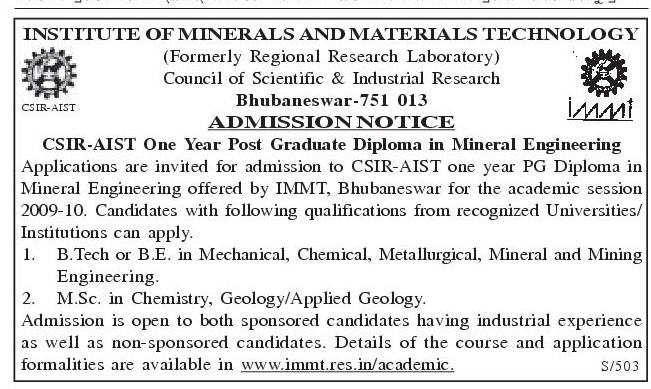
The details of the course is at http://www.immt.res.in/academic/. It looks like a very good program to pursue and should lead to jobs in the various mining and mineral processing plants (including steel and aluminum plants) in Orissa. Following is the program structure.
Duration : The PG Diploma programme will be of one year duration, consisting of two semesters. Both theory classes and practical demonstrations will be taken up during the 1st semester for six courses. During the 2nd semester, the students will be carrying out project work.
1st Semester:
Theory:
| Subject Code |
Subject Title |
| ME-01 |
Characterisation Techniques |
| ME-02 |
Comminution, Classification & Agglomeration |
| ME-03 |
Separation Processes |
| ME-04 |
Surface Phenomena & its Application |
| ME-05 |
Environment & Waste Treatment and Corporate Social Responsibility |
| ME-06 |
Computer Application in Mineral Processing |
Practical Demonstration:
| Mineralogical characterisation |
Agglomeration |
Magnetic Separation |
Jigging |
Fluidisation |
| Comminution |
Dewatering |
Specific Area Measurement |
Tabling |
Electrostatic separation |
| Size separation |
Flotation |
Pychnometry |
Process Simulation |
Fine particle separation |
2nd Semester:
PROJECT WORK & PROJECT REPORT SUBMISSION
Project work to be carried out either at IMMT for students enrolled in ‘non-sponsored’ category or at respective industries for students enrolled in ‘Sponsored’ category.
May 5th, 2009
Number of students registered for NEST 2009, the entrance examination for NISER and UM-DAE
As per http://nest.niser.ac.in/choosecentre.php the number of students registered for NEST and their centers are:
- Ahmedabad: 168
- Allahabad: 285
- Bengaluru: 174
- Bhopal: 577
- Bhubaneswar: 3303
- Chandigarh: 413
- Chennai: 418
- Dehradun: 165
- Delhi: 1458
- Guwahati: 159
- Hyderabad:727
- Jaipur: 653
- Jammu: 61
- Kochi: 539
- Kolkata: 1192
- Lucknow: 841
- Mumbai: 837
- Nagpur: 270
- Panaji: 25
- Patna: 830
- Raipur: 262
- Ranchi: 526
- Sambalpur: 248
- Shillong: 17
- Simla: 38
- Srinagar: 14
The total is 14,200. (Last year 8,000 appeared NEST.) The total number of seats that are available this year are 52 in NISER and 30 in UM-DAE.
May 2nd, 2009
NISER makes 31 offers for permanent faculty positions
(Ack: Thanks to Mr. Rakesh Kumar for the pointer.)
Lets hope most of them accept these offers. The list is at http://niser.ac.in/notices/2009/Faculty-selected-Apr-09.pdf. Below are images of that list.
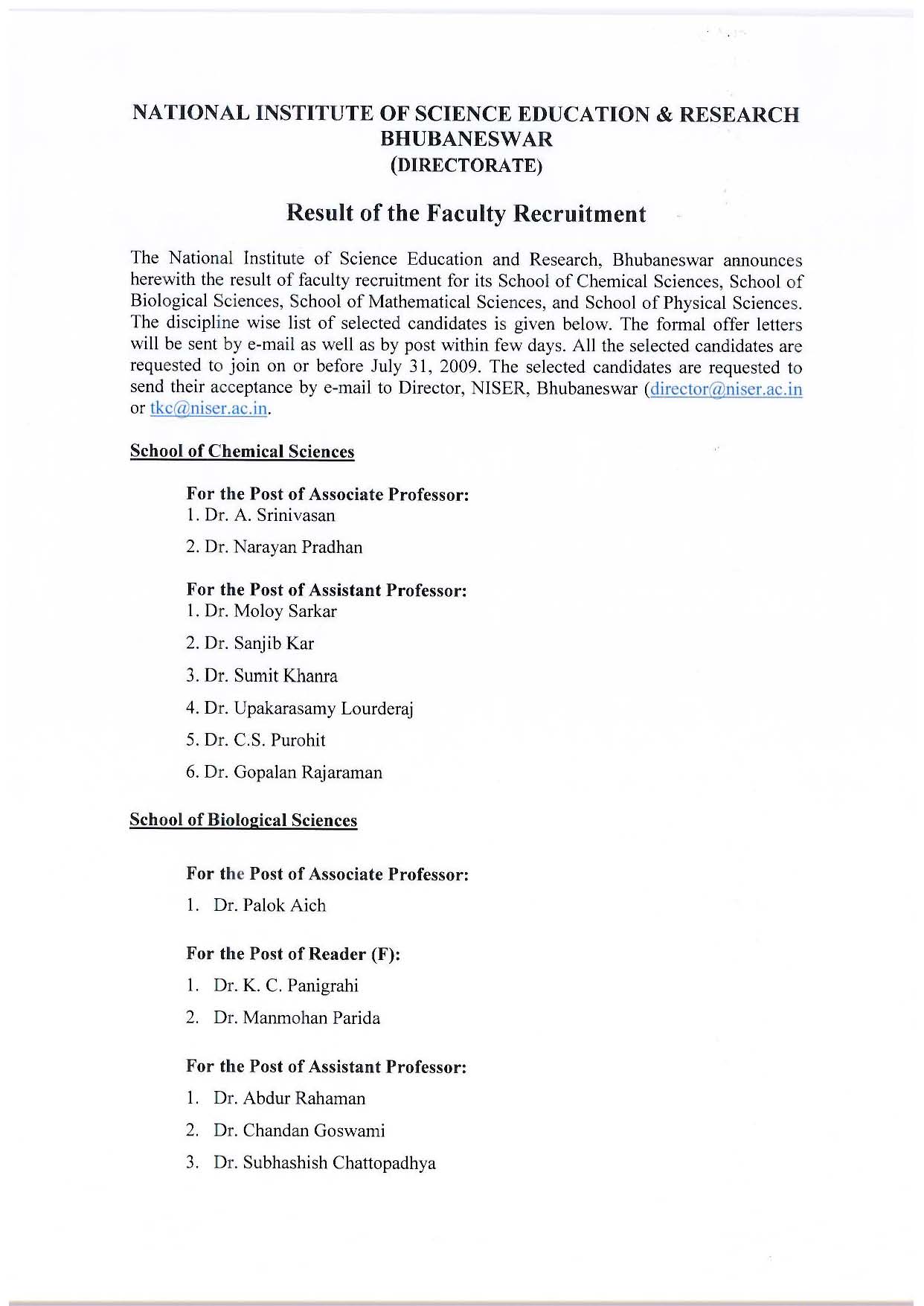
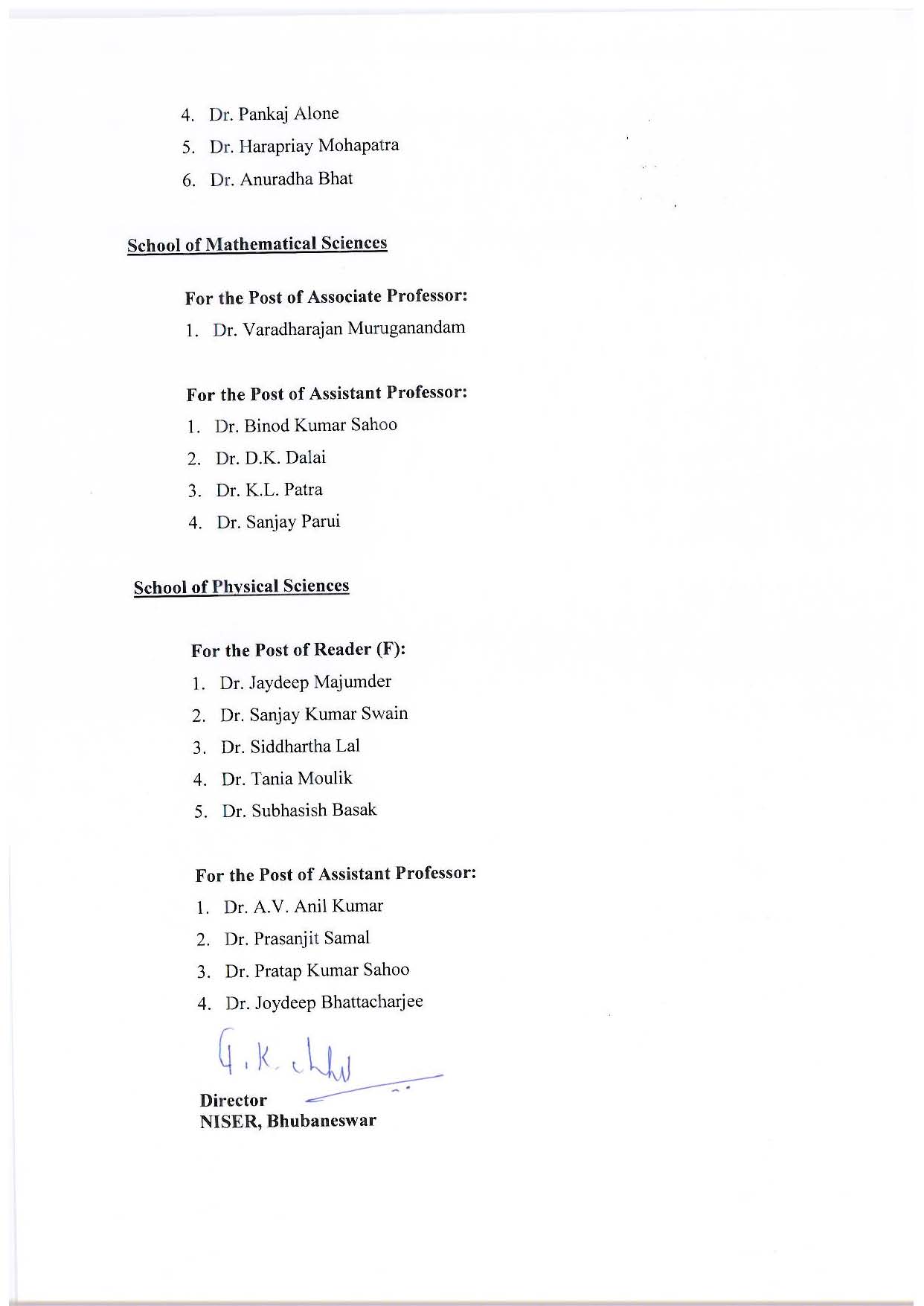
April 9th, 2009

